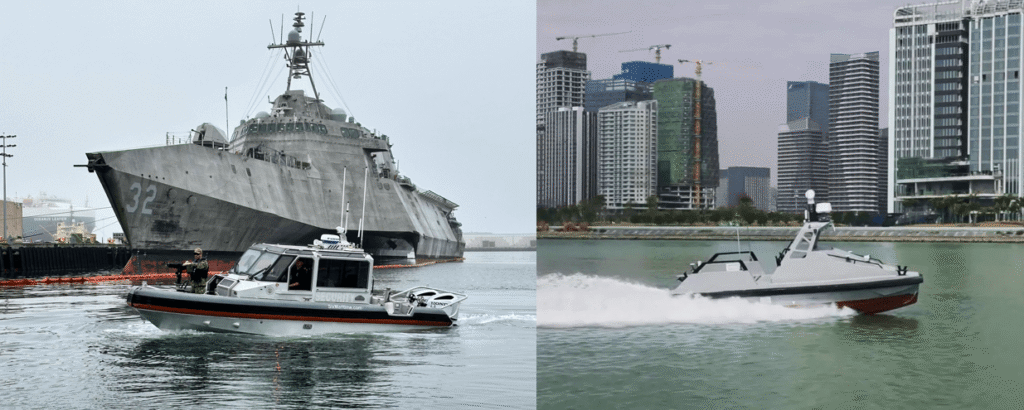
Six Maritime patrol craft securing a U.S. Navy vessel (left) contrasted with a futuristic unmanned surface vessel concept (right). The image reflects the balance between proven operational experience and the promise of emerging autonomy.
The September 2025 Proceedings article, The Emperor’s New Vessels: A Call for Realism in Maritime Autonomy by Bo Jardine, strikes a chord with anyone who has spent time on the water. It is a warning that resonates across our industry: hype alone does not keep ships safe, nor does it defend coastlines or ensure readiness. The metaphor, as used by Jardine in his article, alludes to Andersen’s fable The Emperor’s New Clothes, a timeless caution against vanity and illusion. In today’s naval technology environment, the stakes are much higher, sailors’ lives, the credibility of American deterrence, and the resilience of our industrial base.
The promise of Unmanned and Autonomous Surface Vessels (USVs/ASVs) is compelling. Swarms of low-cost, risk-tolerant vessels conducting surveillance, mine countermeasures, and even strike missions could transform naval warfare. But Jardine’s caution is well-placed: if we build a fleet on PowerPoint slides and AI-generated renderings rather than rigorous, real-world testing, we risk leaving warfighters exposed with hollow capabilities.
The Danger of Illusion
Many of today’s proposed platforms are just that, proposals. Lightweight hulls with limited endurance, concepts that have never endured a heavy sea state, and systems unproven against the complexities of port operations or contested communications environments. To place national security on the shoulders of untested designs is to gamble not only with taxpayer dollars but with deterrence itself.
And yet, the answer is not to halt innovation. It is to pace it, to prove it, and to ground it in operational experience. This is where companies like Six Maritime bring value.
Six Maritime’s Perspective: Over 600,000 Hours of Reality
Over the last decade, Six Maritime has accumulated more than 600,000 operational hours protecting U.S. Navy warships in domestic maritime environments. That experience is not hypothetical, it is earned through night patrols in San Diego Bay, security evolutions in Jacksonville, and escort missions during Navy Weeks and Fleet Weeks nationwide.
From that vantage point, we have witnessed the gap between marketing promises and maritime realities. We have seen unmanned platforms falter when faced with tides, weather, or the unpredictable behavior of the human maritime environment, fishermen cutting across restricted zones, recreational boaters ignoring security perimeters, and adversaries probing for weaknesses.
This is why we agree with Jardine’s central point: the Navy and its industry partners must demand clarity, accountability, and measured progress.
Optional Manning as the Bridge
One of the strongest recommendations in Jardine’s article is the emphasis on optional manning. In contested environments, autonomy must not be brittle. When sensors are spoofed or communications are jammed, a human crew remains the most reliable safeguard against mission failure.
Six Maritime has long advocated for this blended approach. Our operational concept of pairing manned patrol craft with autonomous systems reflects both caution and ambition. Autonomous vessels can expand domain awareness, execute intercept patterns, and extend coverage. But human mariners remain the decision-makers, ensuring that every mission ends with success rather than ambiguity.
Optional manning is not a half-measure, it is a phased pathway. It allows us to integrate autonomy responsibly, leveraging technology where it is strongest while ensuring resilience through human oversight.
Class Standards and Dual-Use Lessons
Another key insight from Jardine’s piece is the need to borrow from the commercial sector. Offshore oil and gas operators do not bet their safety on unproven designs. Their vessels meet stringent class approvals from ABS, DNV, Bureau Veritas, and Lloyd’s. They survive years of heavy use in some of the most unforgiving maritime environments on earth.
For naval autonomy, the lesson is clear: future USVs and ASVs must be built to class standards, designed not only for glossy renderings but for decades of operational resilience.
At Six Maritime, we see opportunity here. Tier 2 and Tier 3 U.S. shipyards, often overlooked in the defense industrial base, are well positioned to build dual-use platforms that meet both commercial and military demands. Our experience operating within NAVSEA 009-72 compliance environments and working alongside Navy shipyards gives us a unique vantage point to help bridge that design and testing gap.
The Role of Six Maritime in R&D
Jardine warns against being “captivated by innovation for its own sake.” We agree. Six Maritime is not chasing the illusion of full autonomy tomorrow. Instead, we are positioning ourselves as the operational testbed for tomorrow’s technologies.
We are actively seeking partners in the AI and USV development space who recognize the value of 600,000+ hours of real-world data and the disciplined pacing of integration. Our message is straightforward: let us be the lynchpin that ensures your platform succeeds in the field, not just on a slide deck.
From side-scan sonar for diver detection to counter-USV tactics tested in live security zones, our work has already shown that autonomy without operational grounding is fragile. With us, developers can de-risk their technologies before they face the crucible of national defense.
A Balanced Path Forward
The future Navy fleet will be autonomous in part. But it must be more than spectacle. By combining optional manning, class-approved hulls, and operationally validated systems, the U.S. can integrate autonomy without repeating the emperor’s mistake.
Six Maritime stands ready to support that future. Our blend of proven manned security operations and forward-leaning autonomous integration provides a disciplined, realistic, and mission-focused pathway.
The stakes are too high for illusions. Our sailors and Marines deserve capabilities that are tested, trusted, and ready. That is the Navy we need, and the one Six Maritime is committed to helping build.
Learn more about how Six Maritime is helping shape the disciplined future of AI and unmanned systems in maritime security at www.sixmaritime.com.
